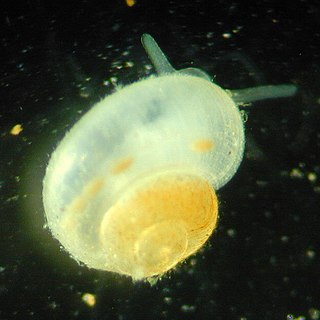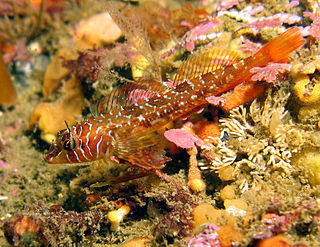Tryonia is a genus of freshwater snails in the family Hydrobiidae. This genus is sometimes placed in the family Cochliopidae.

Melongena is a genus of sea snails, marine gastropod mollusks in the family Melongenidae, the crown conches and their allies.
The Blue Spring aphaostracon or Blue Spring hydrobe, scientific name Aphaostracon asthenes, is a species of minute freshwater snail with a gill and an operculum, an aquatic gastropod mollusk in the family Cochliopidae.
Aphaostracon is a genus of very small or minute freshwater and brackish water snails that have an operculum, aquatic operculate gastropod mollusks in the family Cochliopidae.
The dense hydrobe, scientific name Aphaostracon pycnus, is a species of small freshwater snails with a gill and an operculum, aquatic gastropod mollusks in the family Cochliopidae.

Acavidae is a taxonomic family of air-breathing land snails, terrestrial pulmonate gastropod mollusks in the superfamily Acavoidea.

Cochliopidae is a family of small freshwater snails with gills and an operculum, aquatic gastropod mollusks. Paludestrina d'Orbigny, 1840 is an archaic synonym, and has been placed on the Official Index of Rejected and Invalid Names by ICZN Opinion 2202.
The Friasian age is a period of geologic time within the Early Miocene epoch of the Neogene, used more specifically within the SALMA classification of South America. It follows the Santacrucian and precedes the Colloncuran age.
Littoridinops palustris is a species of very small aquatic snail, an operculate gastropod mollusk in the family Hydrobiidae.
Pyrgophorus platyrachis is a species of very small aquatic snail, an operculate gastropod mollusk in the family Hydrobiidae.
Heleobops is a genus of very small aquatic snails, operculate gastropod mollusks in the family Cochliopidae.
Littoridinops is a genus of very small aquatic snails, operculate gastropod mollusks in the family Hydrobiidae.
Pebasiconcha immanis is an extinct species of air-breathing land snail, a terrestrial pulmonate gastropod mollusk in the family Acavidae.
Floridobia is a genus of very small freshwater snails that have an operculum, aquatic gastropod molluscs or micromolluscs in the family Hydrobiidae, the mud snails.
Caiman wannlangstoni is an extinct species of caiman that lived in what is now the Amazon Basin and surrounding areas during the Middle and Late Miocene. Fossils of C. wannlangstoni have been found in the Pebas Formation near Iquitos in Peru and include partial skulls and isolated skull bones. Other fossils were uncovered from the Urumaco Formation in Venezuela and the Laventan Honda Group of Colombia. The species was first described in 2015 and the name honors Wann Langston, Jr., a paleontologist who studied South American fossil crocodylians for many decades. Features that in combination distinguish C. wannlangstoni from other caimans include a deep snout, a wavy upper jaw margin, a large and upward-directed narial opening, and blunt teeth at the back of the jaws. Based on the sizes of the skulls, its estimated body length is about 211 to 227 centimetres.
Kuttanacaiman is a monotypic genus of extinct caiman represented by the type species Kuttanacaiman iquitosensis. Kuttanacaiman lived in what is now the Amazon basin during the Middle Miocene, approximately 13 million years ago (Ma). The species was named in 2015 on the basis of one nearly complete skull and a second partial skull from the Pebas Formation near Iquitos, Peru. K. iquitosensis is characterized by a short, rounded snout and blunt teeth at the back of its jaws that were likely adapted to crushing freshwater bivalves. Its estimated total body length is 171.2 to 189.1 centimetres.
Gnatusuchus is an extinct genus of caiman represented by the type species Gnatusuchus pebasensis from the Middle Miocene Pebas Formation of Peru. Gnatusuchus lived about 13 million years ago (Ma) in a large wetland system called the Pebas mega-wetlands that covered over one million square kilometers of what is now the Amazon Basin.




